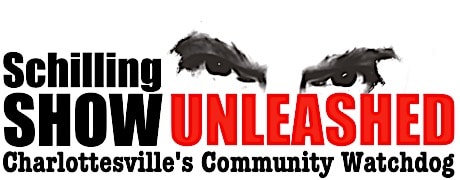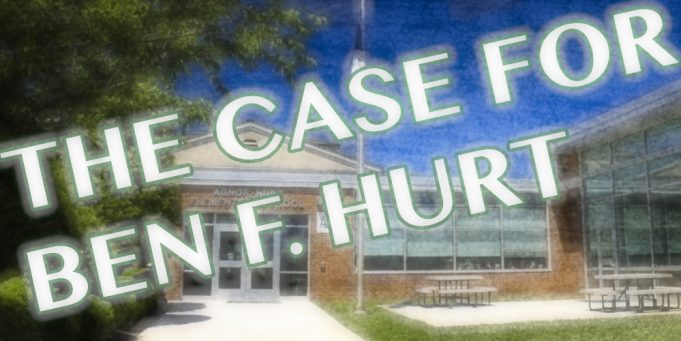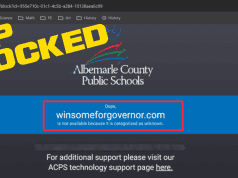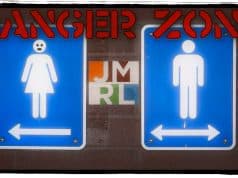by Barb Fitzgerald
 I was late getting onto the charges of racism and failures of oversight leveled against long-time Albemarle High School principal Ben F. Hurt by the Albemarle County School Board, as well as its decision to rename Agnor-Hurt Elementary School. For some reason the board eliminated one step in the renaming process only in the case of Mr. Hurt, disallowing proper community input or a customary amount of time for response and expediting a vote soon after the report and recommendation from the Project Manager for School Name Reviews. As a result, the matter was a “done deal” before supporters of Hurt could react.
I was late getting onto the charges of racism and failures of oversight leveled against long-time Albemarle High School principal Ben F. Hurt by the Albemarle County School Board, as well as its decision to rename Agnor-Hurt Elementary School. For some reason the board eliminated one step in the renaming process only in the case of Mr. Hurt, disallowing proper community input or a customary amount of time for response and expediting a vote soon after the report and recommendation from the Project Manager for School Name Reviews. As a result, the matter was a “done deal” before supporters of Hurt could react.
With a little research, it soon becomes apparent that these racism and implied dereliction of duty charges against a number of the county’s prominent educators over the past five years have been made without regard to the truth or facts or logic. Even when their “evidence” has been totally disproved, as is the case with Mr. Hurt, the board refuses to reverse itself, to admit error or to offer apology to the families they have distressed beyond words. It’s time this board was called out for their reckless accusations and slanderous attacks on good men.
THE BOARD’S YEARBOOK CHARGES AGAINST MR. HURT, NOW PROVEN FALSE
When I first heard the flimsy, ridiculous accusations against Ben Hurt, I thought there surely must be something else. In what universe would it seem like a good idea to re-evaluate a renowned principal’s worthiness to be the namesake of a school through a handful of yearbook photos from 60 years ago, photos found wanting when judged by “current values”? I was so disbelieving that I actually phoned a member of the Board of Supervisors to ask, “Is there anything else you county leaders know about this that I don’t know—Any racist statement he made? Any racist action he took? Any prior complaints of racism? There was nothing else—and nothing at all, either, to substantiate the “evidence” the school board had cited in their review.
THE SO-CALLED “EVIDENCE”
1 & 2) Two of the five photos cited were of a student at an AHS sporting event, in a group shot, holding up a Confederate flag. One appears to be near a concession stand, with a parent and child in the background, the other at a game or rally. Such flags were common at athletic events in the South then—less so today—with little consideration of their symbolism or intent. A teacher at Albemarle High in the 1960s stated before the board that AHS had a football rivalry with Lee High of Staunton, a team known as the “Rebels,” who traditionally brought Confederate flags to wave wildly when their team scored, and that the AHS flag was a taunt of Lee High’s tradition, with the flag on the Albemarle’s side waved gleefully when the Patriots scored. While we can’t know what one individual student intended, a search did show that Lee High was indeed on the schedule in 1968, the year that particular yearbook was published.
3& 4) Two other race-related yearbook photos were identified as students in blackface at minstrel shows, but that description is inaccurate. One photo was indeed from a minstrel show, a fundraiser for the Boosters’ Club, an organization of the parents of AHS athletes that raised money to update athletic equipment, uniforms, etc. This was not a school function, taking place in the evening in the school auditorium. Pictured is Gene Corrigan, then the Athletic Director at UVA and later the Commissioner of the Atlantic Coast Conference interacting on stage with an adult in blackface. The second photo cited was not a minstrel show at all but a snapshot from the junior class talent show in which a student in blackface seems to be evoking Al Jolson.
5) The fifth and final photo cited was of a group of boys at a locker, with one of the students wearing a black armband with a swastika on it. When I saw that photo, I knew for sure that Mr. Hurt had never seen this yearbook before it was published. Ben Hurt was a veteran of WWII who rose to the rank of sergeant major, the highest rank available to an enlisted man in the U. S. Army. He was in WWII as long as our country was, from 1941 to 1945—a strong patriot who served from Africa to Anzio, and that swastika photo would never have been approved by him had he seen it in advance.
REFUTATION OF ALL YEARBOOK PHOTO CHARGES
1) WITNESS: At the May 9 school board meeting, Mrs. Courtenay Stanley, the advisor to the AHS yearbook, The Peer, for 22 years, testified that in all the years she worked with the yearbook, Mr. Hurt never once saw any text, any photos, any layout, nothing of the yearbook until the printed book was put in his hands. How, then, could he be responsible for photos he never even saw?
2) GUILT BY FAILURE OF OVERSIGHT:
He had oversight, the board would say. In not pre-approving each yearbook and school paper, Mr. Hurt was entrusting the seniors who created the publications to edit them according to “current values,” meaning in these two instances, the values of 1963 and 1968. It might surprise some to learn that censorship or editing of a public school publication is fraught with possible legal consequences, as well as being a violation of some of the pillars of American democracy such as freedom of speech and freedom of the press. Basically, as you will discover with an online check, as long as the publication is not libelous or obscene and its distribution not disruptive, “officials cannot legally censor it.” I don’t know if Mr. Hurt knew that, but he certainly knew the value of allowing his student leaders to do the job they had earned the right to do.
I can add after many years in academia myself that giving the senior journalism students their heads on yearbook and newspaper production is pretty standard practice. Yearbooks and school papers are by the students, for the students, of the students, and as Mrs. Stanley attests, Mr. Hurt (and many other administrators) never proofed, edited, censored or reviewed that work in advance. The work was done after school, the funds to publish were raised by students who sold advertising, and the photos to be used were student selected. (I can personally confirm that when I edited the AHS newspaper in ’58-’59, Mr. Hurt never saw copy or photos until I handed him the printed paper in the hall.)
3) To question Mr. Hurt’s “oversight” of school publications is to ignore, then, the limits of his powers as principal, the accepted practice of freedom of the press as applied to school print publications, and the impossibility of one man dictating every single thing that goes on in a school. (Jimmy Carter was reported to have kept up with the number of yellow legal pads in the Oval Office closet, but micro-managing didn’t make him a great president.)
CHARGES OF MISUSE OF FACILITIES AND, AGAIN, OVERSIGHT FAILURES
1) NO RESEARCH: Mr. Hurt was accused of making the school auditorium available for offensive performances (minstrel shows, for instance), but no investigation was apparently made as to WHO actually made the decisions about auditorium use, who had the oversight Mr. Hurt was condemned for misusing. If it turns out (as it does) that after-hours facility use was never his bailiwick, how can he be blamed? Apparently no effort was made to find the facts on this issue—just another unfounded and inaccurate charge by a school board run amok.
REFUTATION OF MISUSE OF FACILITIES CHARGE
1) NO FINAL OVERSIGHT: A long-time employee at the school board office during the minstrel show years remembers that approval for outsider use of the AHS auditorium rested with several offices and several people, and that Mr. Hurt did not have the final say-so. A petitioner had to first pick up a form at the school board office downtown, fill it out, and take it to Mr. Hurt’s office. Someone there would look it over and make sure there was no scheduling conflict or problem with the organization (Boosters’ Club, in this case). The form would then go back to the school board office for a final going over to ensure the group making the request was comprised of responsible adults, etc. Approval was usually pretty much a matter of course. After all, the building did in effect belong to the public, and all the administrators involved were generally happy to share it, as Mrs. Stanley suggested in her testimony before the board.
2) Obviously, use of the auditorium originated with the form from the school board office, and Mr. Hurt’s office was the second step, not the deciding authority.
I point out that Mrs. Stanley, 22-year advisor to the yearbook, as well as the employee from the central office for at least that long, were very easy to find. Had the school board and its advisory committees made any effort at all to confirm their speculations about racism photos or facility use, the answers were readily available.
I further point out that after the facts and testimonies were made available to the board, they chose to ignore the truth and the evidence and merely repeated that the renaming of Agnor-Hurt was a “done deal” and the renaming would stand.
BOARD CONCERNS RELATING TO LION’S CLUB MEMBERSHIP: INVALID
1) “A lifetime member of the Crozet Lion’s Club, Hurt was part of a group that used these kinds of shows for fundraising and entertainment,” say the anti-racism activists. Actually, this “group” is and was an international humanitarian, civic and service organization known for its efforts on behalf of world peace, promoting ecology, and fighting blindness and vision problems worldwide. We know them best, not for minstrel shows, but for their ongoing collecting of used eyeglasses for refurbishing and international distribution, as well as for medicines and other treatments for failing vision and blindness.
2) GUILT BY ASSOCIATION: Minstrel shows were popular and lucrative fundraisers for many years in the 20th century (and even the 19th century, too) and people of all classes and races produced them and attended them. Mr. Hurt, a Lion for 70 years, is accused here of guilt by association. Those with whom he was “associated” would have been his fellow Lions, Presidents Carter, Reagan, Ford and Bush, who were all Lion’s Club members. There are also photos of FDR, Truman, Eisenhower and Kennedy in attendance at minstrel shows. Obviously, times have changed and minstrel shows are no more. As Oprah says, “When we know better, we do better.”
3) Sometimes the good has to outweigh the bad. The Lion’s Club is hardly the Klan. A Klan member is automatically assumed to be a racist; a Lion’s Club member is assumed to be a public-spirited, service-oriented, civic-minded community leader.
4) You join a club or group for one purpose and don’t necessarily support everything it stands for. I joined the ACLU in the mid-60s because it was working hand in hand with the NAACP on Civil Rights issues—causes I supported—but a few years later my ACLU was filing a lawsuit on behalf of a Grand Dragon in support of the Klan’s right to march in a Jewish neighborhood in Skokie, Illinois. I did not resign because, despite the unpleasant diversity of their civil and legal rights interests, the ACLU was hardly a racist institution—in fact, the opposite.
So far as I have found, these facts cover the entire case against Ben Hurt. What a farce! Yet families’ lives have been turned upside down over the past five or six years by a number of such unfounded, frivolous accusations, starting with the assault on Superintendent Paul H. Cale, whose offensive “quoted” comment has turned out not to be a direct quote at all, but a paraphrase. What he actually said is unknown, but those who know him said he would never have said what he was paraphrased as saying. Nevertheless, the board ignores the facts.
Ordinarily, I am one in favor of renaming, certainly in obvious cases. Surely we can all see that a Black youth would not want to go to Stonewall Jackson Middle School or Robert E. Lee Elementary, any more than the teenage me would have wanted to graduate at William Tecumseh Sherman High. The problem at hand is the careless renaming that’s gone too far here in Albemarle County, sweeping up innocent individuals in a flurry of illogic and arrogant virtue signaling.
The changes this board has made in its renaming frenzy have not been necessary or obvious, nor will they improve education in any way. At a time when teachers work in fear at Mr. Hurt’s beloved Albemarle High School (as reported in the local press a couple of months ago), when teachers are cursed and slapped in the face and students freely roam the halls, there are more important things to work toward than promoting the school board’s “currrent values.” Their current values don’t look so good from where I sit.
Nevertheless, to avoid this conflict in the future, with the agreement and support of the community, no school in our county should ever again be named for any individual—and all schools currently named for an honoree should be renamed simultaneously—no signaling out one person or another with selective and speculative judgments, insufficient research, unsubstantiated accusations and questionable decisions that destroy a good name here and break a heart there. Such actions bring great distress to the families and thousands of friends of those who, like Ben F. Hurt, have been unfairly and unconscionably dishonored.
Is this possibly the worst school board Albemarle County has had in many a year?
Barbara Fitzgerald, Rivanna District, is a member of Albemarle High School Class of ‘59








